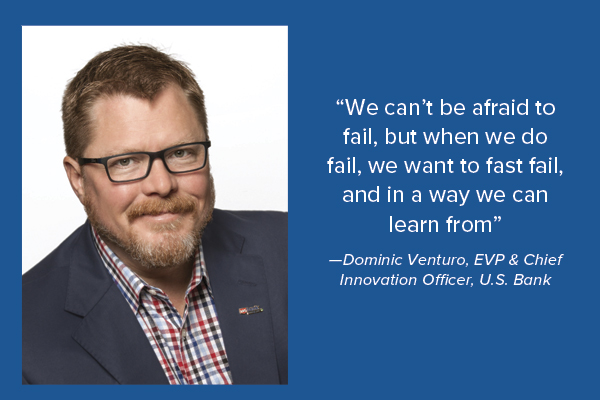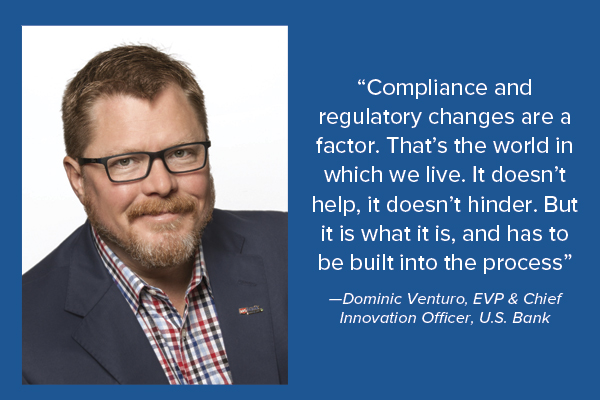Getting inventive in a bank
U.S. Bank innovation chief’s agenda includes everything from mobile enhancements to blockchain’s future
- |
- Written by Steve Cocheo
 Financial innovation follows a similar path to traditional inventing, according to innovation chief Dominic Venturo.
Financial innovation follows a similar path to traditional inventing, according to innovation chief Dominic Venturo.
The history of invention is filled with success stories where the popular end result bears no resemblance to what the inventors set out to produce. Examples include Silly Putty and Post-it Notes.
Sometimes financial innovations can follow even more byzantine paths.
Often U.S. Bank’s lab has launched projects that began very differently from their ending, says Dominic Venturo, executive vice-president and chief innovation officer at U.S. Bank, in an interview with Banking Exchange. He has been in charge of technological innovation there, initially in payments and now overall, for a decade.
Understanding how innovations can evolve and even morph serves Venturo well, right up to his expectations for blockchain technology. A payments evolution story illustrates this.
From a special phone to everyone’s phone
Venturo recalls a project that began in 2008 in an early effort to implement the concept of mobile payments. Venturo says the bank went so far as piloting a complex solution using a dedicated Nokia phone. The pilot didn’t succeed. However, the bank gained valuable experience.
“What we learned from the pilot was that consumers have a close relationship with the phones they already carry,” says Venturo. “And that was a barrier to getting them to adopt another phone to do just one thing.”
And mind you, this was before the ubiquitous presence we see with smart devices had become “normal.”
So then the bank came up with the idea of making a contactless “card”—actually a sticker—that could be affixed to a customer’s own phone, to facilitate mobile payments.
“At the time, I thought it was a silly idea, but it seemed to solve a problem,” says Venturo. “But then we discovered a new problem. Consumers didn’t like having a sticker on their phone.”
For some, covering up their device’s branding with the bank’s sticker detracted from the gadget’s eye appeal. For others, the fact that the sticker could be pulled off and used by someone else didn’t sit well.
The bank had run out of potential solutions to the challenge it had set.
“So we had to shelve this idea for a couple of years, waiting for the right technology to develop,” says Venturo.
Finally, it arrived, in the form of tokenization, which led to mobile wallets and more.
“So now virtually any device being sold today has such capability,” says Venturo. “The original idea wasn’t the one that worked.”
U.S. Bank’s innovation process
“It’s possible to have a completely bad idea,” says Venturo. “That doesn’t happen too often.”
Nevertheless, the inevitable failures teach. “We can’t be afraid to fail, but when we do fail, we want to fast-fail, in a way we can learn from,” says Venturo. The path described above for mobile payments shows how each iteration produced new findings.

And it also illustrates an idea that Venturo calls “the cheese cave”—putting a good idea in storage to develop, much as certain cheeses are wrapped and put in caves to age.
Venturo says he and his team have whiteboarded some concepts that sound great.
“But then we have to park the idea,” he explains, “and wait until technology catches up.”
That’s why Venturo sees his group as not only problem solvers, but opportunity expanders. The overriding preference is for tech solutions that improve the customer experience, rather than innovation for its own sake.
Innovation in a regulated industry
No industry enjoys a complete absence of regulation. Open up a Mac computer and you’ll see references to the Federal Communications Commission right on the motherboard. So even innovative Apple faces rules.
But it is pretty much acknowledged that banks face more red tape and rules than many other industries. This has implications for financial innovation in a bank environment.
“Compliance and regulatory changes are a factor. That’s the world in which we live,” Venturo says. “It doesn’t help, it doesn’t hinder. But it is what it is, and has to be built into the process”

At U.S. Bank, the innovation team pulls in the participation of Compliance early in a project, according to Venturo. Some might bridle at that, holding onto the legacy attitude that the compliance function is the “Department of No.” But Venturo doesn’t buy into the attitude.
“I’m not a fan of linear progression,” says Venturo. “I’m a fan of an agile approach, an ongoing approach.”
For progress to be ongoing, functions like compliance must be woven into the process, he maintains.
First, “you can get a better answer, faster,” says Venturo.
Not behaving this way would also mean bringing projects to Compliance when they have already begun to jell.
“Things actually take longer that way,” Venturo explains.
If an innovator has gone down a bad road, and then brings it to the attention of Compliance, then much time and work may have to be trashed, or possibly undone.
“You would have rework—and rework is bad,” says Venturo.
While Venturo stresses agility and avoidance of rework, a certain amount of reassessment has to be part of the innovation process. He says the group maintains a standing agenda that covers the many areas in its portfolio, from payments to artificial intelligence to digital identity to internet of things to blockchain and more. His group revisits the agenda quarterly, because what seemed important at an earlier point might not be as important now.
Augmented reality—from virtual reality glasses of one kind or another to other variations—seemed important a while back, says Venturo by way of example.
“Now we’re not hearing as much about it,” he explains, so, while research continues, its place in the agenda has changed.
Perspective plays a role in the U.S. Bank innovative process, too. Venturo explains that his product development schedule frequently has a three-to-five-year timeline in mind.
“We tend to have a longer lens,” Venturo explains.
U.S. Bank’s internal team doesn’t just work on its own. Venturo says that the bank partners with outsiders, works with venture capitalists, and invests in tech accelerators and similar research and development groups.
“We know that we can’t develop everything ourselves,” says Venturo.

A peek inside part of U.S. Bank's Lab, called "The Grove."
Looking at blockchain technology
And that “longer lens” brings the conversation to blockchain technology.
U.S. Bank is part of the R3 blockchain development consortium, involving 42 organizations, and has participated in several of R3’s use cases. These are potential applications that “dovetail with our business,” according to Venturo.
One banking area that Venturo sees as a natural for blockchain is syndicated loans. For several reasons, the enormous volume of data, contracts, approvals, and more that go into this multibank process have not been automated. Much of the syndicated loan world runs on paper and on—believe or not— faxing.
Shared access by all parties to a blockchain that administers a given credit or credits would be a major step forward, and could make the whole process faster.
“That would be an interesting problem to solve,” says Venturo.
While a “smart contract” application of blockchain would be useful here, Venturo says that a completely automated approach wouldn’t necessarily be a must, at least not from the beginning. Simply being able to publish terms of credit, and giving all participants in a credit the ability to see automatic updates that can be counted on would be a big step, he suggests. Centralized loan documentation, relying on the trust aspect of the blockchain, also appeals to Venturo.
[Regarding trust, something Venturo is watching that may not be on all bankers’ radar is the issue of “federated identities.” Briefly, this is a way of assuring identity of users in a shared community—one application of the concept is when you use a social media identity as the key to something else on the web. In particular Venturo has been looking at work done by the National Institute of Standards and Technology. Read a recent NIST draft paper.]
That’s just one possibility. Venturo is upbeat on the blockchain, and doesn’t see any scenario where the technology will, after all the buildup, be supplanted by something else before it grows. Sufficient use cases have been run, he believes, for the industry to take the next step.
His sense of the timing of adoption in financial services is that the beginning will be gradual, as legacy systems get replaced by the blockchain, and then, suddenly, the technology will go mainstream.
“You’ll get that surge, at least in certain segments,” says Venturo. “But ubiquity is difficult to predict. Ubiquity is tough to bring about. I couldn’t even give you an educated guess on when that comes.”
What about the school of thought in the blockchain world that believes that, once the technology becomes commonplace, there will be no need for banks?
Venturo is more than skeptical.
“Blockchain is a technology,” he explains. “It’s difficult to see how a technology, by itself, replaces all of the functions provided by banks. I think that that’s a great oversimplification. It is a technology, one that allows for some good things to happen.”
Tagged under Management, Lines of Business, Technology, Fintech, Feature, Feature3,













